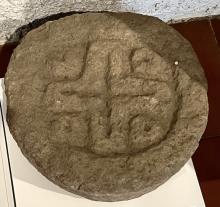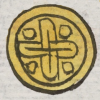teocuitlatl (Mdz57r)
This element for gold (teocuitlatl) is included in this collection as an example of iconography given that we do not have a label that specifically identifies it as teocuitlatl. But it compares quite favorably to elements of compounds that do have supporting glosses. This iconographic example involves a circle with another concentric circle, and inside that one is an interwoven quatrefoil. The entire sign is painted yellow.
Stephanie Wood
The contextualizing image for this gold disc is a grouping of four "insignias" for occupations that a baby might come to hold. Laura Filloy Nadal and María Olvido Moreno Guzmán, in their essay in Mesoamerican Manuscripts (2018, p. XVI), explain that these insignia refer to "carpenters (cuahxinque), featherworkers (amanteca), painters tlacuiloque), and goldsmiths (teocuitlahuaque)." The fourth one insignia includes this yellow circle, representing the occupation of goldsmithing.
Stephanie Wood
c. 1541, or by 1553 at the latest
Stephanie Wood
gold, oro, metales, metals
This stone carving of the teocuitlatl (gold) hieroglyph is here for comparison with the glyphs in the Codex Mendoza. This stone is located in the Museo Xolotl at the archaeological site at Tenayuca (in the region of Tlalnepantla, Mexico City). Photo by Stephanie Wood, 13 August 2023.

teocuitla(tl), gold, silver, precious metal, https://nahuatl.wired-humanities.org/content/teocuitlatl
el oro
Stephanie Wood
Codex Mendoza, folio 57 recto, https://digital.bodleian.ox.ac.uk/objects/2fea788e-2aa2-4f08-b6d9-648c00..., image 124 of 188.
Original manuscript is held by the Bodleian Libraries, University of Oxford, MS. Arch. Selden. A. 1; used here with the UK Creative Commons, “Attribution-NonCommercial-ShareAlike 3.0 License” (CC-BY-NC-SAq 3.0)





